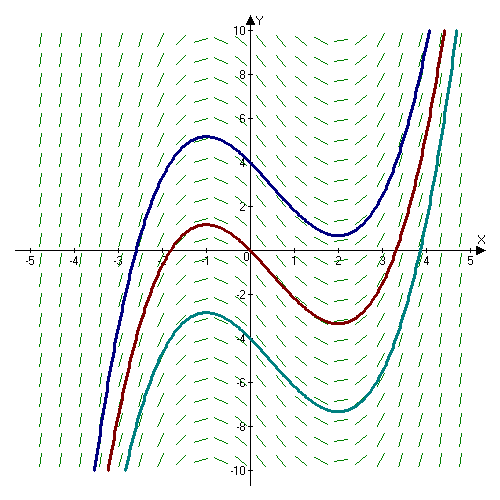
Slope fields (also called direction fields) are a graphical representation of the solutions to a first-order
differential equation
In mathematics, a differential equation is an equation that relates one or more unknown functions and their derivatives. In applications, the functions generally represent physical quantities, the derivatives represent their rates of change, an ...
of a scalar function. Solutions to a slope field are functions drawn as solid curves. A slope field shows the slope of a differential equation at certain vertical and horizontal intervals on the x-y plane, and can be used to determine the approximate tangent slope at a point on a curve, where the curve is some solution to the differential equation.
Definition
Standard case
The slope field can be defined for the following type of differential equations
:
which can be interpreted geometrically as giving the
slope
In mathematics, the slope or gradient of a line is a number that describes both the ''direction'' and the ''steepness'' of the line. Slope is often denoted by the letter ''m''; there is no clear answer to the question why the letter ''m'' is use ...
of the
tangent
In geometry, the tangent line (or simply tangent) to a plane curve at a given point is the straight line that "just touches" the curve at that point. Leibniz defined it as the line through a pair of infinitely close points on the curve. More ...
to the
graph
Graph may refer to:
Mathematics
*Graph (discrete mathematics), a structure made of vertices and edges
**Graph theory, the study of such graphs and their properties
*Graph (topology), a topological space resembling a graph in the sense of discre ...
of the differential equation's solution (''
integral curve
In mathematics, an integral curve is a parametric curve that represents a specific solution to an ordinary differential equation or system of equations.
Name
Integral curves are known by various other names, depending on the nature and interpret ...
'') at each point (''x'', ''y'') as a function of the point coordinates.
It can be viewed as a creative way to plot a real-valued function of two real variables
as a planar picture. Specifically, for a given pair
, a vector with the components
 Slope fields (also called direction fields) are a graphical representation of the solutions to a first-order
Slope fields (also called direction fields) are a graphical representation of the solutions to a first-order  Slope fields (also called direction fields) are a graphical representation of the solutions to a first-order
Slope fields (also called direction fields) are a graphical representation of the solutions to a first-order